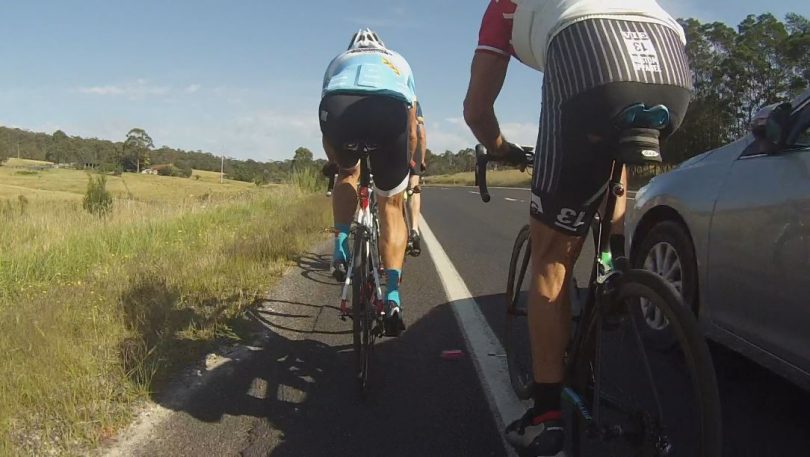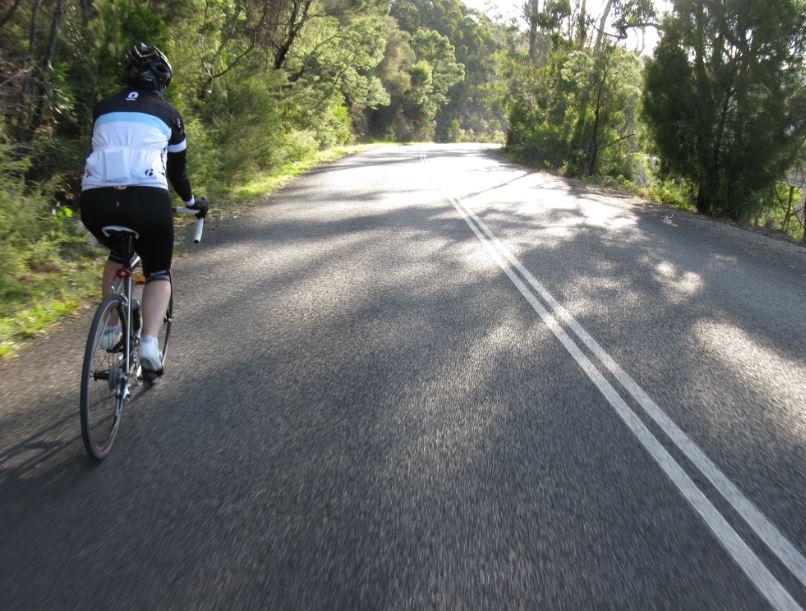
Hardly a 1.5-metre gap – it’s the law. Photo: Kate Smith.
Cyclists in the Canberra region have been shaken by two recent road incidents, including one that resulted in the death of a 72-year-old man.
Police are still investigating the circumstances surrounding the South Coast man’s death, and are appealing to the public for dashcam vision and any information.
About 10:50 am on Saturday 23 June, emergency services were called to Mt Darragh Road at Lochiel, about 20 kilometres north of Eden.
The cyclist had suffered serious injuries and was taken to Canberra Hospital in a critical condition, where he died earlier last week.
Initial inquiries suggest a 37-year-old man stopped his Nissan utility to speak with the cyclist prior to the crash.
Meantime on Thursday (5 July) just after 8:00 pm, emergency services were called to the intersection of Tumut Plains Road and East Street in Tumut after a cyclist was struck by a Toyota Hilux.
The rider, a 50-year-old man, was treated at the scene by NSW Ambulance paramedics before being taken to Tumut Hospital. He was later airlifted to Canberra Hospital with head injuries.
The driver of the Toyota, a 19-year-old man, was uninjured and taken to Tumut Hospital for mandatory blood and urine testing.
These two events follow the death of a 55-year-old female cyclist on Tarago Road at Bungendore in early June, after which a 37-year-old man was charged with dangerous and negligent driving occasioning death.
Merimbula’s Kate Smith has been riding weekly for the last five years and recently contacted The RiotACT on the back of these incidents, keen to promote changed road rules and encourage a culture of sharing local roads.
“The cycling community in the Bega Valley is a very close bunch and we are feeling this loss very deeply,” Ms Smith says.
The informal group of around 25 cyclists Ms Smith rides with, gets together four times a week either riding towards Eden or Wyndham or closer to home around Merimbula and Pambula.
“You won’t ever find us all together at the one time, we are all spread out depending on our ability. I am generally at the back, but I do a couple of hundred kilometres each week,” Ms Smith says.
“It’s a fantastic thing to be doing, that is growing in popularity.
“And when you are riding with a bunch of people you form a great bond, it’s something that turns you from friends into family.”

Motorists can cross double white lines when safe in order to pass a cyclist and give them the space they need. Photo: Kate Smith.
Doug Reckord, from the Bega Tathra Safe Ride committee, sends his condolences to the family and friends of the rider killed and regrets the impact bad news has on peoples’ interest in cycling.
“We know that there is a high number of people who would ride more if they had a safe place to do it,” he says.
Construction of stage one of the Bega Tathra shared pathway is proposed to start in October linking Tathra and Kalaru and separating bicycles, cars, and trucks for roughly 4km.
“This project complements the Bega Valley Bike Plan and that idea of saying – we want you to ride, we want you to ride safely, we want you to get home,” Mr Reckord says.
LIVE with Doug Reckord from the Bega Tathra Safe Ride committee. There is progress on the grand vision to link the two towns with a shared pathway.Woo hoo!Ian
Posted by About Regional on Thursday, July 5, 2018
Like Ms Smith, Mr Reckord says he is mostly comfortable on local roads, but both accept that some cyclists will always want to go ‘beyond a path’, which calls for cooperation and clear heads from all road users.
“The overwhelming majority of the motorists that I encounter between Bega and Tathra are good drivers, they slow down at the crests and the curves, they give you plenty of room,” he says.
Ms Smith says, “We’ll do a ride of 120 kilometres and we accept that cycling is inherently a risky activity, but so is walking out your front door.
“Everything has a degree of risk and we do what we can to minimise that.
“Most car drivers negotiate us without incident. It’s not our intention to obstruct traffic or hinder anyone; we just want to share the road safely.”
Having better-informed road users on two and four wheels is important to both cyclists and the community they ride with.
Mr Reckord says there are a few things you can do that make yourself safer as a rider.
“If you are a bike rider you are vulnerable, you should bear that in mind: hi-viz clothing, lighting on the bike, avoid the peak times if you can as they are not necessarily the best time to be on the road, you might need to go earlier or later,” he says.
“And if you are not confident, look for those safer places to ride.”
Ms Smith believes a lot of people aren’t aware of the road rules.
“About a year and a half ago, road rules changed to allow car drivers to overtake cyclists on double white lines where it is safe to do so,” she says.
“It’s never really been promoted and it often causes frustration.”
On top of that, in NSW and the ACT, drivers who pass a bicycle rider must allow a distance of at least one metre when the speed limit is 60 km/h or less and 1.5 metres when the speed limit is more than 60 km/h.
Cyclists are permitted to ride two abreast on both sides of the border, however, when riding two abreast, riders must travel within 1.5 metres of the other rider. This means that riders should ride as close together as is safe to do so.
There are rules too for bicycle riders. Cyclists must stop at red lights or stop signs, give way as indicated by signage, and give hand signals when changing direction. Under both ACT and NSW road rules, a bicycle is considered a vehicle, which means the same road rules apply.
Ms Smith says attitude and aggression between road users is very frightening.
“We are lucky around here that the roads as so quiet, most of the time we don’t have problems, but when we do it’s really distressing, it makes you feel sick in the guts,” she says.
Police are keen to hear from witnesses to the recent incidents at Lochiel and Tumut or anyone with dashcam vision.












